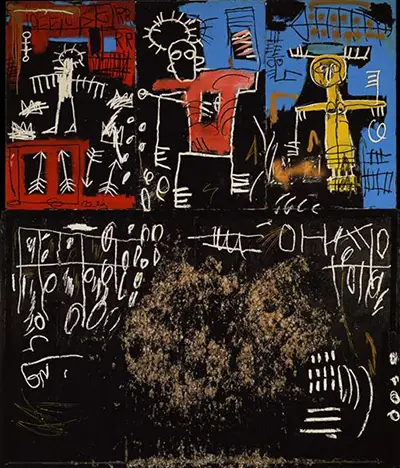The artist put this painting together in 1982, using acrylic, crayon and spray paint on wood. It is now a part of a private collection, which remains the case for a vast majority of this artist's work. His reputation has grown in recent years, and he is now more popular than even during his own lifetime. Those clever enough to have acquired his paintings many decades ago will have earned a huge profit, were they to ever sell on these items today. An additional aspect is the increased exposure of African American artists, which has further fuelled the rise in popularity of Basquiat, who himself was already very well known with art circles. He is considered one of the most influential artists of the 20th century and played an important role in contributing to the growing art scene within New York. He also offered something within this that was entirely unique in style and influence.
We find a couple of grids in the bottom half of the painting, with white lines drawn over the top of the black background. There are small circles outlined within some of the sections of the grid, as well as further doodles to the side. The upper half of the painting is dominated by three different figures who have their arms out wide. Each is fairly simple with outlines in which and then a single tone to create solid form. Feathers are displayed from their arms, almost like elements of a windmill with lines coming off at right angles. Additionally, there are also arrows on the left hand side of the composition as well. Basquiat has a style of depicting figures within his paintings that continued throughout his career and makes many of his artworks instantly recognisable as his own.
The important element of the content is explained by how taring and feathering was actually a punishment given to slaves, a topic that Basquiat was particularly passionate about. He attempted to draw attention to the horrors of this trade in a way that few white artists would have done at this time. He produced a series of politically-themed artworks but also took on other subjects across his career. Religion featured many times as well but his main concern was certainly the experiences of African Americans, something that he could relate to because of both his own roots, but also the difficulties that he had experienced within his own lifetime before his career started to take off.


